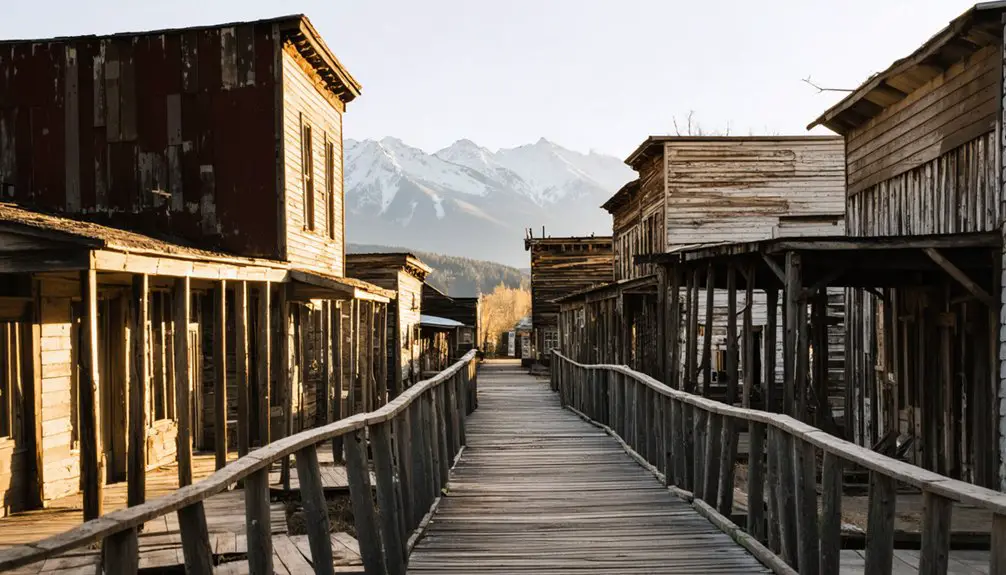You’ll find Sumpter nestled in Oregon’s Blue Mountains, where an 1888 gold discovery sparked a mining boom that transformed a small camp into a thriving city of 1,500 residents. The town extracted over $9 million in gold by 1900, boasting 80+ businesses and modern amenities like brick buildings and plank-paved streets. After a devastating fire in 1917 destroyed twelve blocks of downtown, Sumpter evolved into a historic ghost town where mining’s golden legacy still echoes through preserved artifacts and stories.
Key Takeaways
- Once a thriving gold mining town with 1,500 residents and over 80 businesses during its 1890s peak.
- The devastating 1917 fire destroyed twelve blocks of downtown, causing $500,000 in damage and accelerating the town’s abandonment.
- Produced $9 million in gold by 1900 through various mining methods, from early placer mining to large-scale dredging operations.
- Now a historic ghost town featuring the preserved Sumpter Valley Gold Dredge and railroad attractions for tourists.
- Transformed into a recreation destination offering year-round activities, camping facilities, and guided historical tours.
The Discovery of Gold at Cracker Creek
When prospectors discovered gold at Cracker Creek in 1888, they sparked a rapid transformation of the Oregon wilderness into a bustling mining settlement initially known as Cracker City.
The gold rush brought immediate development, with 20-30 structures quickly emerging to support the flourishing mining operations. You’ll find that within months, about 80 men were working tirelessly on mine tunnels and power ditches for drilling operations. A remarkable discovery in 1900 at the Gibraltar mine yielded ore worth $160,000 per ton.
The district thrived throughout the 1890s, anchored by prominent mines like the North Pole, E&E, Golconda, and Columbia. As word of Cracker Creek’s riches spread, the settlement, later renamed Bourne, grew to accommodate roughly 1,500 residents by the mid-1890s, marking the peak of its mining prosperity. The town was renamed after Jonathan Bourne, a Massachusetts lawyer who influenced the area’s development.
From Fort Sumter to Sumpter: A Name’s Evolution
You’ll find the original name “Fort Sumter” was chosen to honor the famous South Carolina fort where the Civil War began, complete with a local rock formation that reminded settlers of a cannonball.
When establishing the town’s first post office in 1874, officials changed the name to “Sumpter” by adding a “p,” helping distinguish it from its South Carolina namesake.
The modification reflected both the growing town’s desire for its own identity and the Northern sympathies prevalent among the local mining population. Three settlers from the mining technology arrived in 1895, which sparked significant growth in the area. The Carolinans founded the original homestead, setting the foundation for what would become a thriving gold mining town.
Civil War Connection
The intriguing story behind Sumpter, Oregon’s name traces directly to one of the most pivotal moments in American history – the Battle of Fort Sumter.
In 1862, five South Carolinians, carrying their Southern identity westward, established a cabin near Cracker Creek and named it after the iconic Civil War fort where the first shots were fired just a year earlier.
You’ll find that these settlers, bound for California’s gold fields, created a powerful connection between their frontier outpost and the conflict that was dividing the nation.
The timing of their choice – merely a year after Fort Sumter’s surrender to Confederate forces – reflects how deeply the war’s opening battle had affected Americans, even those seeking new opportunities thousands of miles from the battlefield. News of the conflict reached Oregon slowly, as seven batteries opened fire on the fort during that fateful April attack. The fort’s original commander, Major Anderson, and his men received a hero’s welcome when they arrived in New York as heroes, showing how the battle had captured the nation’s imagination.
Postal Office Influence
As postal regulations reshaped America’s landscape in the late 1800s, they played a significant role in transforming Fort Sumter, Oregon into today’s Sumpter.
You’ll find the change stems from 1874 when Joseph D. Young became the first postmaster, establishing essential communication lines in this remote mining region. Similar to the introduction of parcel post service in other towns, this helped reduce shipping costs for local businesses.
The town’s identity shift occurred in 1883 when postal naming rules prevented the reuse of “Sumter.” Rather than abandon their Civil War connection entirely, the community adapted by changing to “Sumpter” – a term for pack animals that actually suited the town’s reliance on mule trains.
This seemingly simple spelling modification reflects how postal regulations directly influenced community identity, while the post office itself became central to Sumpter’s growth, facilitating important trade and communication networks throughout the region. The post office experienced a brief closure in 1878 before reopening in 1883, marking a period of transition in the town’s postal history.
Regional Identity Shift
Since Oregon settlers established their community in 1862, they drew inspiration from Fort Sumter, South Carolina – the site of the Civil War‘s first battle.
You’ll notice a fascinating cultural transformation that occurred as the town evolved from its military namesake to forge its own unique identity.
The identity evolution became official in 1883 when the spelling changed from “Fort Sumter” to “Sumpter.”
This shift wasn’t just about postal regulations – it reflected the town’s changing character. The added “p” connected to the term “sumpter” (pack mule), acknowledging the essential role of mule trains in the region’s mining economy.
The mining boom brought tremendous growth, as the population reached 3,000 residents during the peak of gold discovery.
The original Fort Sumter was designed as a massive coastal fortification with five-foot-thick brick walls that symbolized military might.
The Railway That Changed Everything
During 1890, construction of the Sumpter Valley Railway marked the beginning of a transformative era for Eastern Oregon’s mining and lumber industries.
You’ll find this railway innovation stretched across 80 miles of challenging mountain terrain, reaching the state’s highest rail elevation at Dixie Summit (5,238 feet).
The railway’s impact was revolutionary. When you examine the freight transportation network, you’ll see how it connected Baker City to essential gold mining operations and Oregon Lumber Company’s sawmills.
By 1910, the line reached Prairie City, creating a lifeline between isolated mountain communities. You could transport timber, ore, and general goods while the railroad’s specialized infrastructure, including the four-stall engine house at Bates, supported the region’s industrial boom.
This narrow-gauge system literally paved the way for Eastern Oregon’s economic golden age.
Life in the Queen City’s Golden Era
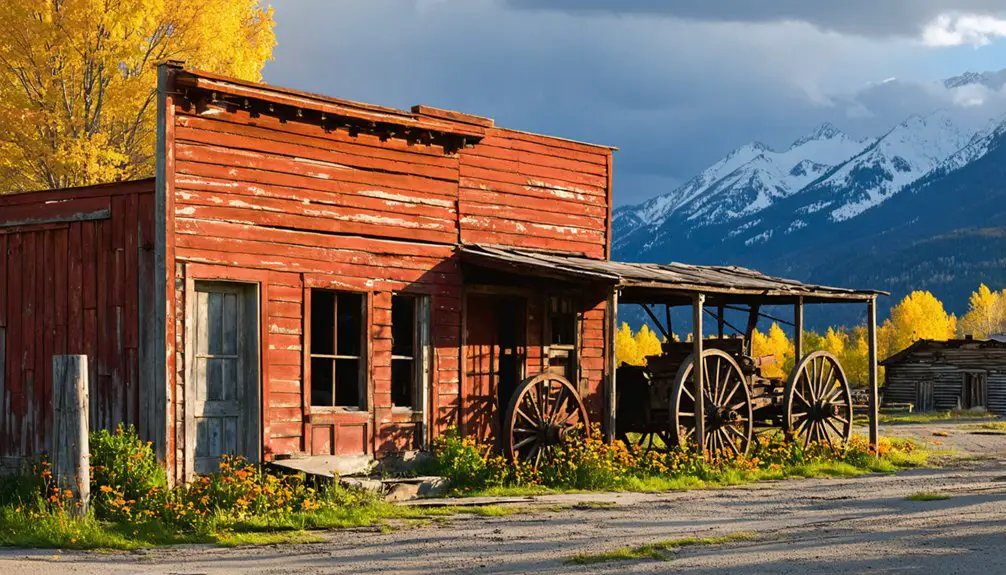
If you’d stepped into Sumpter during its golden era, you’d have found a bustling Queen City alive with the sounds of miners, merchants, and entertainers filling its plank-paved streets and brick buildings.
The town’s 3,500 residents enjoyed amenities rivaling larger cities, including an opera house, multiple hotels, sixteen saloons, and three newspapers that kept the community informed and connected.
Mining wealth fueled a vibrant social scene where cultures mixed freely, from Jewish merchants to immigrant miners, all contributing to the town’s reputation as a sophisticated mining hub rather than just another rough frontier outpost.
Daily Life and Entertainment
While gold brought people to Sumpter, the Queen City’s vibrant social scene kept them entertained.
You’d find yourself with plenty of options for social activities, from theatrical performances at the opera house to lively gatherings at any of the 16 saloons. The dance hall hosted both formal and casual events, while the shooting gallery and photographic gallery offered unique diversions.
Community events often centered around the town’s multipurpose venues, where you could mingle with fellow residents and transient miners alike.
When night fell, the electric light plant kept the festivities going. Whether you were seeking entertainment at the brewery, catching up on local news from one of three newspapers, or trying your luck at gambling, Sumpter’s bustling social scene rivaled any major city of its time.
Community Pride and Success
Prosperity defined Sumpter’s golden era as the Queen City emerged as eastern Oregon’s premier mining hub.
With $9 million in gold extracted by 1900, you’d have witnessed a thriving metropolis showcasing remarkable community resilience through its advanced infrastructure and diverse economy.
The town’s economic legacy was evident in:
- Sophisticated urban amenities including brick buildings, plank-paved streets, and modern utilities
- Over 80 businesses ranging from banks to cigar factories
- Multiple cultural venues like an opera house and churches
- Extensive public services including schools and volunteer fire department
You’d have found a self-sufficient community of 3,500 residents enjoying the fruits of their success, with the Sumpter Valley Railway connecting them to broader markets and opportunities.
Local entrepreneurs built a diverse commercial landscape that served the region’s needs.
Mining Culture and Society
Although Sumpter began as a modest gold discovery in 1862, it rapidly evolved into a sophisticated mining powerhouse where you’d have witnessed the transformation from simple gold panning to massive dredge operations.
Life in Sumpter revolved around the 24/7 rhythm of the mines, with skilled crews operating the massive dredges around the clock.
You’d have found yourself among a diverse mining workforce of prospectors, machine operators, and maintenance workers, all adapting to the isolated mountain conditions.
The arrival of the railroad in 1897 connected this bustling community to the outside world, while local infrastructure grew to support the booming gold industry.
At its peak, you’d have experienced a vibrant town where millions in gold flowed through the community, creating a unique culture centered on frontier prosperity and shared mining heritage.
Mining Methods Through the Years
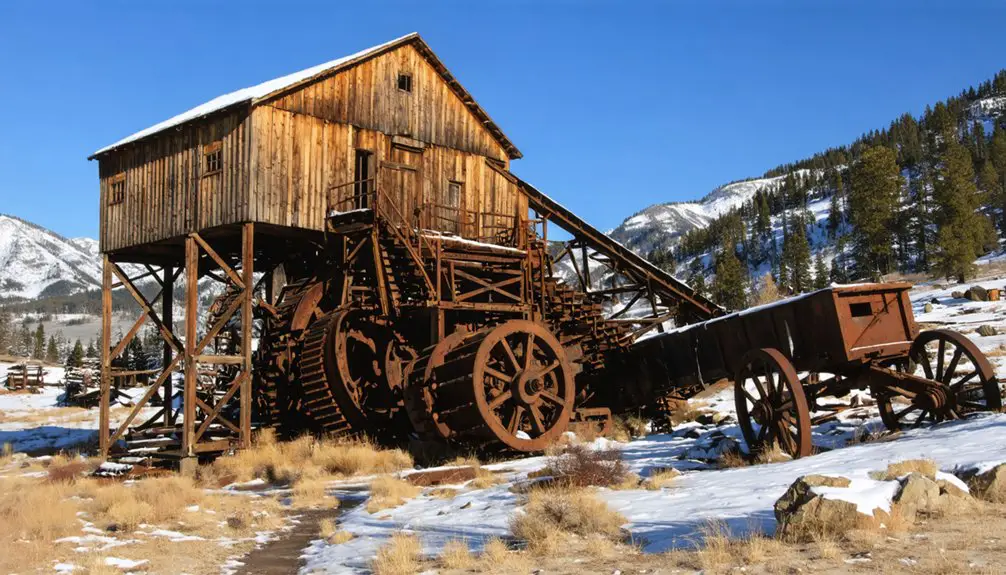
When prospectors first discovered gold near Sumpter in 1862, they relied on basic placer mining techniques like panning and sluicing to extract gold from creek gravels and riverbeds.
By the late 1800s, hard rock mining emerged as miners began extracting gold from quartz veins deep within the earth.
The evolution of mining methods in Sumpter followed this progression:
- Manual placer mining with simple tools and pans (1860s-1890s)
- Heavy machinery and mechanized extraction after railroad arrival (1890s-1910s)
- Large-scale dredging operations with floating dredges (1913-1954)
- Modern recreational panning and small-scale mining (1954-present)
The most impressive operation was the Sumpter Valley Gold Dredge No. 3, which used 72 one-ton buckets to dig through riverbeds, processing materials through complex separation systems and recovering over $4.5 million in gold.
A Cultural Hub in the Mountains
During Sumpter’s heyday in the late 1800s, you’d have found a bustling social scene with an opera house, brewery, and multiple saloons serving the town’s 5,000 residents.
You couldn’t walk the wooden streets without encountering miners fresh from their claims, railway workers between shifts, and traders conducting business in this essential cultural hub.
The town’s churches, newspapers, and various entertainment venues created a vibrant community atmosphere that defined Eastern Oregon’s frontier lifestyle.
Entertainment and Social Life
As Sumpter flourished into the “Queen City” of Oregon’s mining region, its entertainment and social scene rivaled that of much larger metropolitan areas. You’d find theatrical performances at the opera house, while sixteen saloons and seven hotels hosted lively social gatherings throughout town.
The town’s vibrant culture centered around these key entertainment venues:
- An opera house featuring musical and theatrical shows
- Seven hotels catering to travelers and social events
- Sixteen saloons serving as community gathering spots
- Two churches doubling as social and religious centers
With over 3,500 residents at its peak, you could experience everything from newspaper discussions to outdoor recreation.
Seven stagecoach lines connected you to surrounding camps, while the red-light district and various businesses created a diverse social landscape that defined Sumpter’s dynamic character.
Community Gathering Spaces
Though Sumpter’s population has dwindled since its heyday, the town’s rich cultural heritage lives on through its diverse community gathering spaces.
You’ll find the heart of local activity at the Community Center and Fairgrounds, where flea markets and social gatherings bring the region together three times yearly. The town’s museums and interpretive centers showcase mining history while hosting educational talks and exhibitions that strengthen community bonds.
At the Sumpter Valley Dredge State Heritage Area, you can explore the massive preserved gold dredge from May through October, joining guided tours and community events that celebrate the town’s mining legacy.
The surrounding mountain landscape offers year-round outdoor spaces, from hiking trails to snowmobile routes, where you’ll experience the authentic intersection of historic culture and modern mountain life.
The Great Fire of 1917
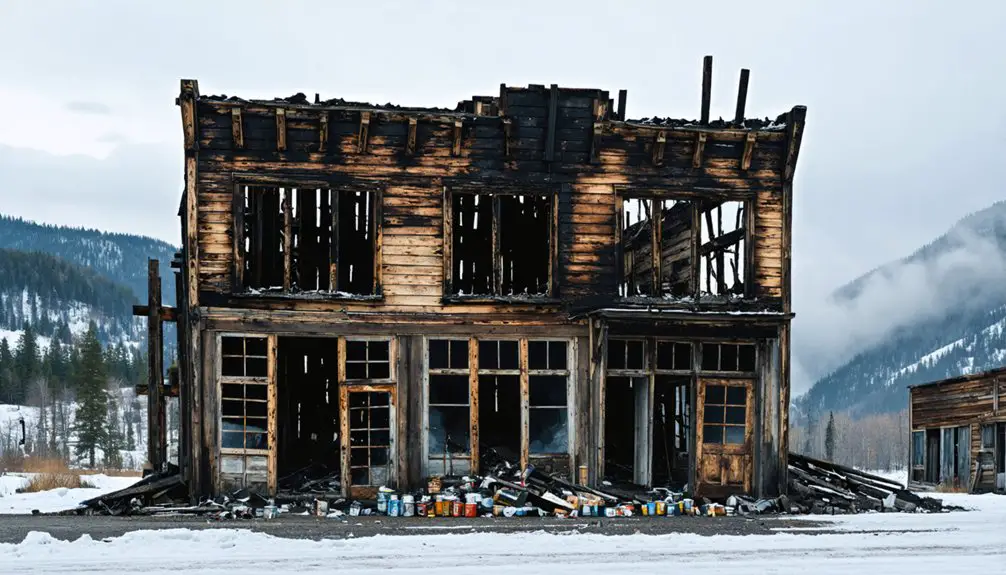
The devastating fire that consumed Sumpter on August 13, 1917, marked a turning point in the town’s history.
What started as a blaze in the Capital Hotel quickly engulfed the town’s wooden structures, overwhelming firefighting efforts despite the heroic actions of volunteers and telephone operators Miss Harris and Miss Hauser.
The economic impact was staggering, with losses reaching $500,000 as the fire destroyed:
- Twelve blocks of downtown businesses and homes
- The stone-built Masonic Hall and First National Bank
- The Presbyterian Church and Sumpter Hotel
- Nearly 100 buildings across one square kilometer
You’ll find that this catastrophe accelerated Sumpter’s decline, as residents and miners abandoned the once-prosperous “Queen City” for opportunities elsewhere, leaving behind a landscape of blackened ruins where a thriving mining hub once stood.
Preserved Mining Heritage
Modern-day visitors to Sumpter can explore two significant preserved mining heritage sites that showcase the town’s golden era.
You’ll find the Cracker Creek Museum of Mining, an outdoor facility with self-guided exhibits of mining equipment and interpretative signage detailing underground mining operations. Just east of the main highway, it’s accessible year-round.
The crown jewel of Sumpter’s mining heritage is the 1935 Sumpter Valley Gold Dredge, now a State Heritage Area.
This massive floating machine, which produced over 128,570 troy ounces of gold, demonstrates the impressive mining technology of its time.
Though the dredge’s environmental impact remains visible in the ten-foot-tall tailings that stretch for miles, the site now serves as an educational center where you can take guided tours and explore the museum’s historic artifacts.
Adventure and Recreation Today
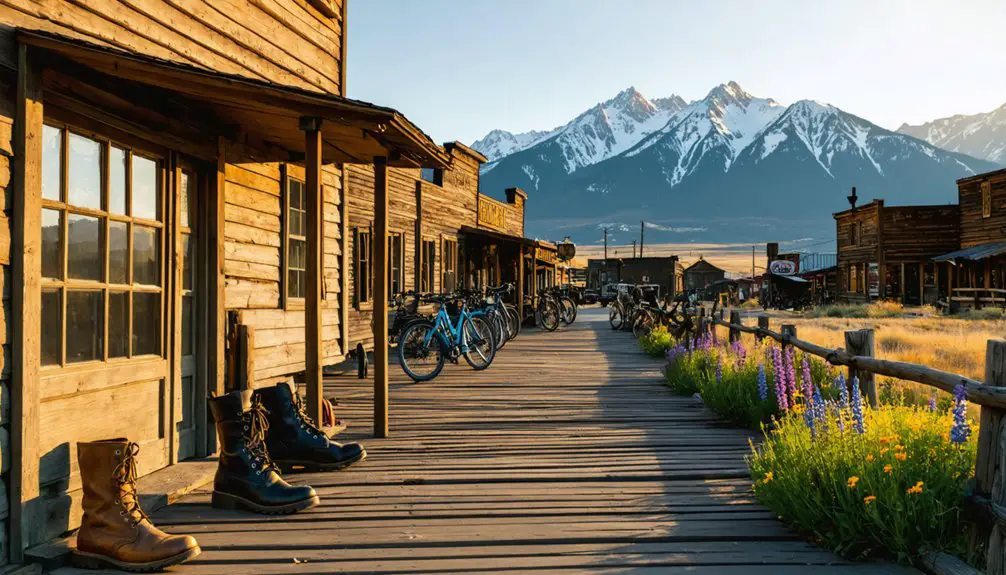
Despite its ghost town status, Sumpter bustles with year-round outdoor activities that draw adventure seekers from across the Pacific Northwest.
Once a sleepy ghost town, Sumpter now thrives as an outdoor recreation hub drawing thrill-seekers to its mountain wilderness.
You’ll find endless opportunities for exploration, from riding ATVs through mountain trails to fishing in pristine waters. Historical tours of the Sumpter Valley Gold Dredge let you connect with the area’s rich mining past while enjoying modern recreation.
Your adventure options include:
- Winter sports like snowmobiling and cross-country skiing in the Blue Mountains
- Water activities on nearby lakes and rivers, including boating and fishing
- Trail exploration via hiking, backpacking, or ATV riding
- Gold panning and dredge tours at the State Heritage Area
The surrounding 95-acre state park provides camping facilities, while local lodging guarantees you’ll have a comfortable base for your outdoor pursuits.
Connecting Communities: The Sumpter Valley Network
Built in 1890, the Sumpter Valley Railroad transformed Eastern Oregon’s isolated mountain communities into a thriving network of interconnected settlements.
You’ll discover how this narrow-gauge railway, winding through challenging mountainous terrain, created unprecedented railroad impact by connecting remote towns like Whitney, Larch, and Prairie City.
The railroad’s influence on community cohesion went far beyond just transporting lumber and gold ore.
You’re looking at a crucial lifeline that enabled residents to move freely between previously isolated settlements, fostering both social and commercial relationships.
As trains navigated the steep grades to Dixie – Oregon’s highest rail point at 5,238 feet – they carried not just freight but also the promise of economic diversification, linking agricultural producers and logging operations to broader markets throughout the region.
Frequently Asked Questions
What Is the Current Year-Round Population of Sumpter?
You’ll find around 209-210 people living there year-round, with demographics heavily skewed toward retirees over 65. Despite its historical significance as a mining town, it maintains a stable, permanent population.
Are There Any Hotels or Lodging Options Still Operating Today?
Like beacons in the night, you’ll find lodging options at the Depot Inn Motel and Sumpter Stockade Motel, plus you can choose from various accommodation choices including cabins and vacation rentals nearby.
What Happened to the Original Gold Mining Equipment and Machinery?
You’ll find most original gold mining equipment preserved at the Sumpter Valley Dredge State Heritage Area, where historical preservation efforts maintain the iconic third dredge and its machinery for public tours.
Can Visitors Legally Keep Gold They Find While Panning?
You can keep gold you find while panning on public waterways, but you’ll need to verify land ownership and follow mining laws. At Sumpter Valley Dredge, you must purchase any gold flakes found.
Does Sumpter Experience Extreme Weather Conditions That Might Affect Tourist Visits?
You won’t face extreme temperatures or severe weather patterns that’ll disrupt your visit. Summer highs reach 92°F, winter lows near 34°F, with mild winds and brief showers being typical.
References
- https://www.legendsofamerica.com/or-sumpter/
- https://westernmininghistory.com/towns/oregon/sumpter/
- https://www.youtube.com/watch?v=6zz4Frnz0qE
- https://traveloregon.com/things-to-do/culture-history/ghost-towns/sumpter-2/
- https://www.historicsumpter.com/whitney-oregon-ghost-town/
- http://historicalgazette.net/cracker.htm
- https://westernmininghistory.com/towns/oregon/bourne/
- https://travelingadventuresofafarmgirl.com/2016/09/27/mining-in-the-sumpter-valley-and-beyond-offers-history-galore/
- https://travelbakercounty.com/cracker-creek-museum-of-mining/
- https://westernmininghistory.com/mine-detail/10036537/
